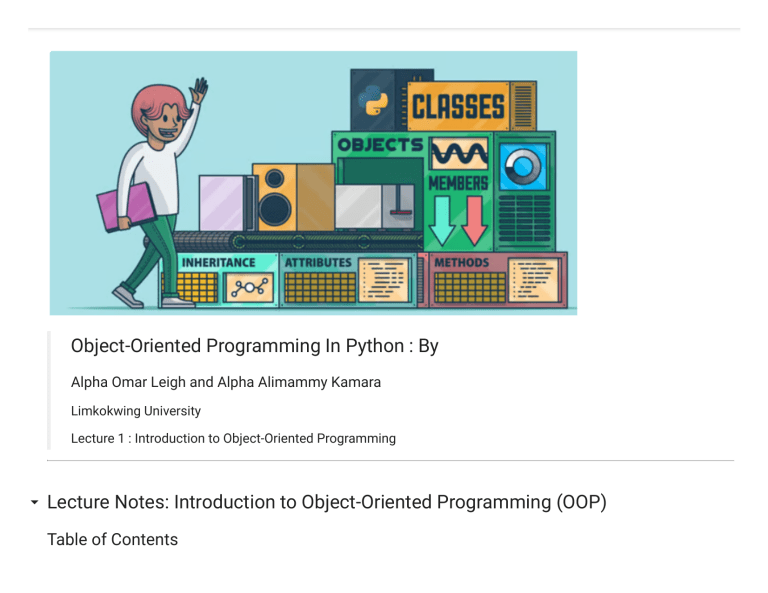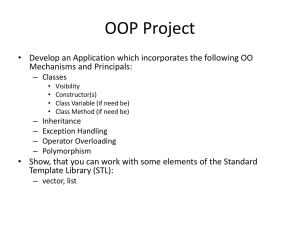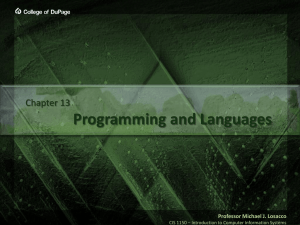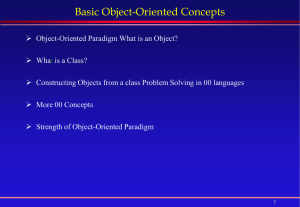
Object-Oriented Programming In Python : By Alpha Omar Leigh and Alpha Alimammy Kamara Limkokwing University Lecture 1 : Introduction to Object-Oriented Programming Lecture Notes: Introduction to Object-Oriented Programming (OOP) Table of Contents 1. Introduction 2. Historical Context 3. Core Concepts of OOP 1. Classes and Objects 2. Encapsulation 3. Inheritance 4. Polymorphism 4. Advantages of OOP 1. Modularity and Reusability 2. Abstraction and Flexibility 3. Maintainability and Scalability 4. Collaborative Development 5. Functional Programming vs. OOP 6. Scenario Examples 1. Banking System 2. Online Shopping Platform 7. Conclusion Lesson Objectives Understand the historical context and evolution of Object-Oriented Programming (OOP). Explain the core concepts of OOP, including classes, objects, encapsulation, inheritance, and polymorphism. Discuss the advantages of OOP in software development, such as modularity, reusability, and maintainability. Differentiate between Functional Programming and OOP. Explore practical scenario examples of OOP in action. Recognize the significance of OOP in modern software development. I. Introduction Object-Oriented Programming (OOP) is a groundbreaking programming paradigm that revolutionized the landscape of software development. It introduced a profound shift in how programmers approach problem-solving and code organization, leading to more efficient and maintainable software systems. Traditional procedural programming, while effective for smaller programs, struggled to cope with the complexity of managing larger software projects. As systems grew in size and scope, procedural code became harder to understand, modify, and maintain. This challenge prompted the need for a new approach that could handle this complexity in a more organized manner. OOP emerged in the late 1960s and early 1970s as a direct response to these challenges. It proposed a radical departure from the linear, top-to-bottom execution of procedural programming. Instead, OOP introduced the idea of encapsulating data and behavior within self-contained units called "objects." These objects could be manipulated and interacted with, mimicking realworld entities and their relationships. Example: Consider a simulation of a car manufacturing process. In a procedural paradigm, you might have functions for assembling each car part, leading to a cluttered and tangled codebase. In OOP, you would define a Car class that encapsulates the properties (attributes) and actions (methods) of a car. Each individual car in the simulation becomes an instance of the Car class. This approach provides a clear structure, making it easier to manage, modify, and extend the simulation. The introduction of objects and classes in OOP provided a natural way to model real-world entities and their interactions. Concepts like abstraction, inheritance, and polymorphism further enhanced the ability to design software systems that accurately mirrored the complexities of the real world. OOP's influence has been profound, with its principles being adopted in various programming languages and frameworks. By understanding OOP, developers gain a powerful toolkit for creating adaptable, scalable, and maintainable software solutions, aligning their code with the dynamic nature of modern applications. II. Historical Context Procedural Programming: Prior to OOP, programming was mainly done using procedural languages like Fortran and COBOL. These languages focused on organizing code as a sequence of procedures or functions. Simula: In the 1960s, Ole-Johan Dahl and Kristen Nygaard developed Simula, a programming language that introduced the concept of classes and objects. It laid the foundation for OOP. Smalltalk: In the 1970s, Alan Kay and his team at Xerox PARC created Smalltalk, a pure OOP language that heavily influenced modern OOP languages like Java and C++. C++: Bjarne Stroustrup developed C++ in the early 1980s by adding object-oriented features to the C programming language. C++ combined OOP with the efficiency of C. Java: In the mid-1990s, James Gosling and his team at Sun Microsystems created Java, a versatile and platform-independent language that popularized OOP for enterprise and web applications. III. Core Concepts of OOP 1. Classes and Objects 1. Classes and Objects A class serves as a fundamental building block of Object-Oriented Programming. Think of it as a blueprint or template that describes the structure and behavior of objects. Classes encapsulate both data attributes and the methods that operate on that data. Example: Imagine you're designing a software system for managing a library. You might create a Book class that defines the attributes of a book, such as its title, author, and publication year. Additionally, you can include methods like borrowBook() and returnBook() to manipulate the book's state. An object is an instance of a class, created based on the class's blueprint. It represents a concrete realization of the abstract structure defined by the class. Objects have their own unique data and can execute the methods defined by their class. Example: Using the Book class from the previous example, you can create objects representing specific books in the library. For instance, you could create an object book1 based on the Book class, setting its attributes (title, author, publication year) to match a particular book in the library's collection. Similarly, you can create another object book2 with different attributes, representing a different book. The class-object relationship provides a powerful mechanism for designing modular and reusable code. Instead of duplicating code for each individual entity, you define the class structure once and then create multiple instances (objects) that adhere to that structure. This approach not only simplifies code maintenance but also allows you to model complex real-world systems more accurately. Example: In a game development scenario, you might have a Character class that defines common attributes like health and abilities. By creating instances of this class, you can easily generate different characters within the game, each with its own unique attributes and behaviors. Overall, the distinction between classes and objects forms the core foundation of Object-Oriented Programming. Classes provide the blueprint, while objects bring that blueprint to life, enabling developers to model and manipulate a wide range of entities and scenarios in their software systems. 2. Encapsulation Encapsulation is a key principle in Object-Oriented Programming that revolves around bundling data and methods that manipulate that data within a single unit, which is typically a class. This encapsulated unit acts as a protective barrier, controlling how the internal state of an object can be accessed and modified from outside. Example: Consider a BankAccount class that encapsulates information about a customer's bank account, such as the account balance. The balance data should not be directly accessible or modifiable from external sources. Instead, you might provide methods like deposit() and withdraw() that allow controlled access to modify the balance. This encapsulation prevents unauthorized changes to the account balance and ensures that changes are made through well-defined methods. Encapsulation promotes data integrity by preventing unintended or incorrect modifications to an object's internal state. It enforces a clear separation between the implementation details (data attributes) and the ways that data can be manipulated (methods). Example: Imagine a Student class that encapsulates a student's personal information, including their date of birth. By encapsulating the date of birth attribute and providing a method to calculate the student's age, you ensure that the age is always accurate and up-todate, regardless of how the birthdate is stored internally. Beyond data protection, encapsulation also enhances code maintainability. If changes need to be made to the internal implementation of a class (e.g., changing how data is stored), encapsulation allows you to update the internal details without affecting the external code that interacts with the class. Example: Consider a TemperatureSensor class used in a weather monitoring application. If you decide to switch to a different sensor technology, you can modify the internal implementation of the class without altering the code that uses the sensor's data, thanks to encapsulation. In summary, encapsulation ensures that the complexity of an object's internal workings remains hidden, providing a controlled interface for interacting with the object. This principle enhances code reliability, security, and maintainability, making it a fundamental pillar of Object-Oriented Programming. 3. Inheritance Inheritance is a powerful concept in Object-Oriented Programming that enables a class (called a subclass or derived class) to inherit attributes and methods from another class (called a superclass or base class). This mechanism encourages code reuse by allowing you to build upon existing classes, creating more specialized versions with additional features. Example: Consider a Shape class that defines basic properties like color and position. You can create subclasses like Circle and Rectangle that inherit attributes from the Shape class. These subclasses can then add their own unique properties and methods specific to circles and rectangles, while still inheriting common behavior from the base Shape class. Inheritance establishes a hierarchy among classes, where more specific classes (subclasses) inherit traits from more general classes (superclasses). This hierarchy not only promotes code reuse but also enhances code organization and understanding. Example: Imagine a software system for managing various types of vehicles. You might have a Vehicle superclass that includes attributes like speed and fuelLevel . Subclasses like Car and Motorcycle can inherit these attributes while adding their own features, like the number of doors for a car and the type of engine for a motorcycle. 4. Polymorphism Polymorphism is a powerful concept that allows objects of different classes to be treated as objects of a common superclass. This flexibility enables you to write code that can work with different types of objects without needing to know their exact class. Example: Consider a Shape superclass with a common method calculateArea() . Subclasses like Circle and Rectangle can implement their versions of calculateArea() based on their specific formulas. In the code, you can create a list of various shapes (circles, rectangles) and iterate through them, calling the same calculateArea() method. Polymorphism ensures that the appropriate version of the method is invoked based on the actual object type. Polymorphism also allows you to define a common interface that multiple classes adhere to. This interface consists of method names that participating classes must implement, even if the implementations vary. Example: Consider an interface Drawable with a method draw() . Both a Circle class and a Rectangle class can implement the Drawable interface and provide their own implementations of the draw() method. This allows you to treat both circles and rectangles as drawable objects, regardless of their specific implementations. In summary, polymorphism enhances code flexibility by allowing you to write code that works with a variety of objects while maintaining a clear and consistent interface. This principle is especially valuable when dealing with complex systems and dynamic scenarios. IV. Advantages of OOP 1. Modularity and Reusability OOP encourages code modularity, allowing developers to divide complex systems into manageable components (classes). Objects can be reused in different projects, saving development time and effort. 2. Abstraction and Flexibility Abstraction simplifies complex systems by focusing on essential features while hiding unnecessary details. OOP provides flexibility through polymorphism, allowing interchangeable components. 3. Maintainability and Scalability Encapsulation and well-defined interfaces make code easier to maintain and extend without disrupting other parts of the system. Changes can be localized to specific classes, reducing the risk of introducing bugs. 4. Collaborative Development OOP's structured design promotes collaboration among developers, as different team members can work on separate classes concurrently. V. Functional Programming vs. OOP When exploring programming paradigms, it's important to understand the differences between Functional Programming and ObjectOriented Programming (OOP). These two paradigms offer distinct approaches to structuring and solving problems in software development. Functional Programming Functional Programming (FP) is a paradigm that treats computation as the evaluation of mathematical functions. It emphasizes immutability, where data structures are not modified once created, and declarative programming, where the focus is on expressing what should be done rather than how it should be done. Example: In a functional program, you might define a function to calculate the factorial of a number. This function takes an input and produces an output without altering any external state. The immutability principle ensures that the input remains unchanged throughout the computation. FP promotes the use of higher-order functions, which are functions that can take other functions as arguments or return them as results. This enables the creation of concise and expressive code. Example: In FP, you can use a higher-order function like map to transform elements in a list. Instead of writing explicit loops, you pass a transformation function to map , which applies the function to each element in the list. Object-Oriented Programming (OOP) OOP centers around modeling real-world entities and their interactions as objects. It emphasizes encapsulation, which bundles data and methods into a single unit, inheritance, which promotes code reuse, and polymorphism, which enables interchangeable behavior through common interfaces. Example: Imagine a simulation of a zoo. OOP allows you to create classes like Animal , Bird , and Mammal , each with their own attributes and methods. You can then create specific instances of these classes to represent individual animals in the zoo. OOP is well-suited for modeling systems with complex interactions and hierarchies. It provides a structured and intuitive way to represent entities and their relationships. Example: In a game development scenario, OOP allows you to create classes like Player , Enemy , and Item . These classes can inherit common attributes and methods from a shared superclass, promoting code reuse. Additionally, polymorphism allows you to use a uniform interface for interacting with different types of game entities. Choosing the Right Paradigm The choice between FP and OOP depends on the problem at hand and the programming style you prefer. Functional programming excels in scenarios where immutability and declarative expressions are essential, such as in mathematical computations or data processing. OOP shines when dealing with complex systems that involve interactions between different entities. Ultimately, both paradigms have their strengths and can complement each other. Developers often combine elements from both paradigms to create well-structured and efficient software solutions that address a wide range of challenges. VI. Scenario Examples 1. Banking System Classes: Account , Customer , Transaction Objects: SavingsAccount , CheckingAccount , Customer1 , Customer2 Encapsulation: Hide account balance and provide methods for deposits and withdrawals. Inheritance: Subclasses SavingsAccount and CheckingAccount inheriting from superclass Account . 2. Online Shopping Platform Classes: Product , User , Order Objects: Laptop , User1 , User2 , Order123 Polymorphism: Different product types using a common method for calculating shipping cost. Abstraction: Users interact with products and place orders without needing to know internal details. VII. Conclusion Object-Oriented Programming (OOP) revolutionized software development by introducing the concepts of classes and objects, encapsulation, inheritance, and polymorphism. Its historical evolution, advantages, and scenarios showcase its importance in building modular, maintainable, and scalable software systems. OOP is a versatile paradigm used in languages like Java, C++, and Python, enabling developers to model real-world entities effectively. By understanding and applying OOP principles, you'll be well-equipped to design and build robust software systems that meet the demands of modern applications. Review Questions: 1. Define Object-Oriented Programming (OOP) and explain how it revolutionized software development. 2. What historical challenges in software development prompted the emergence of OOP? 3. Describe the core concepts of OOP: classes, objects, encapsulation, inheritance, and polymorphism. 4. How does encapsulation contribute to code security and maintainability? 5. Compare and contrast Functional Programming and OOP in terms of their principles and advantages. Quiz: Introduction to Object-Oriented Programming (OOP) Question 1 What is the purpose of a class in Object-Oriented Programming? a) To store data b) To define a blueprint for creating objects c) To perform mathematical computations d) To manage input/output operations Question 2 Inheritance is a concept in OOP that allows: a) Objects to inherit attributes from other objects b) Classes to inherit attributes and methods from other classes c) Objects to be created without classes d) Methods to inherit properties from other methods Question 3 What is the primary benefit of polymorphism in OOP? a) It allows for the creation of multiple classes b) It simplifies the process of data encapsulation c) It enables objects of different classes to share common behavior d) It ensures immutability of data attributes Question 4 Which programming paradigm emphasizes treating computation as the evaluation of mathematical functions? a) Object-Oriented Programming b) Functional Programming c) Procedural Programming d) Imperative Programming Question 5 How does encapsulation contribute to code maintainability in OOP? a) It allows for direct modification of object attributes b) It hides implementation details of a class c) It prevents the use of methods in a class d) It promotes global access to data attributes Question 6 What is an example of a real-world scenario that can be modeled using OOP? a) Solving mathematical equations b) Organizing a grocery list c) Simulating a zoo with different animals d) Creating a simple calculator Question 7 Which principle of OOP ensures that an object's internal state is protected from unauthorized access? a) Inheritance b) Encapsulation c) Polymorphism d) Abstraction Question 8 Functional Programming emphasizes: a) Using loops and iterative constructs b) Modifying data in-place c) Treating computation as mathematical functions d) Avoiding the use of functions Q ti 9




